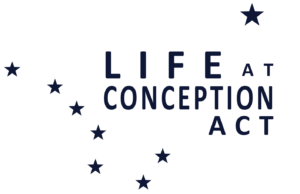LIFE AT CONCEPTION
an·swers
a thing said, written, or done to deal with or as a reaction to a question, statement, or situation.
Before we identify top questions about the Life At Conception Act, let’s consider where the past 49 years have brought us:
- Alaska was among the first states legalizing abortion in 1970, three years before Roe v Wade.
- Alaska leads the nation again as a model state for abortion access according to the Guttmacher Institute and NARAL / Pro-Choice America.
- Alaska is one of the few states with “Constitutional Protections” to abortion access.
- Alaska is one of the few states with no meaningful restrictions on abortions from the moment of conception to birth.
- Alaska is also one of the few states that pays for nearly 3 out of 4 babies it kills every year.
- Alaska is one of the few states that pays for babies to be killed in another state.
QUESTION 1
WhyThe LIFE At Conception Act
When considering ProLife legislation to pursue, we have many considerations – many difficulties that must be overcome in Alaska Statute, Constitution, and Roe v Wade.
Questions that must be answered:
- Does the bill honor the principles of personhood?
- Life begins at conception
- Every human being has a God-given right to life and is a person from the moment of conception to natural end of life.
- Legislation and regulation must never discriminate against any child regardless of:
- Size
- Level of development
- Location – whether in the womb or out
- Degree of dependency
- Nature of conception
- Is the bill part of a comprehensive approach to ending abortion?
- Or is it an incremental bill that is part of a comprehensive approach?
- If it’s an incremental bill that is not a part of a comprehensive approach, what benefits does it offer in contrast to the challenges it creates?
- Is the bill enforceable? If not, why make a new law?
- If the bill IS enforceable, what exceptions are included in the bill?
- Rape and incest
- Health of the mother
- Life of the mother
- Fetal anomalies
- Etc.
- If the bill IS enforceable, what exceptions are included in the bill?
- If the bill includes exceptions, how will those exceptions either challenge or conform to Roe v Wade and Doe v Bolton?
- Will the bill be overturned in the courts? If so, why make the new law?
- State courts
- District courts
- U.S. Supreme Court
- If the bill is overturned in lower courts but stands a strong chance of challenging Roe v Wade at the Supreme Court, is the bill a sufficient challenge to Roe v Wade to justify the challenge?
- Is the bill a comprehensive approach to ending abortion?
- Does the bill address only a component of Roe?
- If so, how much of Roe will remain should the Alaska law be successful in challenging Roe?
- Will personhood rights be re-established?
- Will Roe’s viability limitations remain?
- Will rape and incest exception requirements remain?
- Etc
- If so, how much of Roe will remain should the Alaska law be successful in challenging Roe?
- How does the bill affect friends and enemies of children waiting to be born?
- Will the bill help friends and enemies raise money?
- Will the bill help friends and enemies recruit more volunteers?
- Will the bill help friends and enemies politically?
There are many more considerations that must be weighed which will be addressed in following posts.
LIFE AT CONCEPTION ACT
ANSWERS
The LIFE At Conception Act is a comprehensive bill that eliminates legalized child killing in Alaska from the moment of conception without exception to the child’s age, level of development, disability, sex, nature of conception, or any other distinguishing characteristic.
The LIFE At Conception Act protects all innocent human life from the moment of conception to natural death by addressing several points in Alaska’s Constitutional and Statutory Laws:
- Is enforceable
- Can be defended at State, District, and U.S. Supreme Courts
- Directly challenges Roe v Wade on all components of the decision and following case law.
- Is a comprehensive approach that supports other incremental bills
- Will completely eliminate abortions in Alaska when signed into law and implemented.
- Eliminates abortion access from the right to privacy, as found in Article 1, Section 22 of the Alaska State Constitution.
- Defines children in the womb from the moment of conception as ‘natural persons.’
- Defines conception as the beginning of the biological development of a human organism, when the sperm and egg fuse.
- Defines abortion as the action taken before or during the birth of a child with the intent to kill the child.
- Repeals Alaska’s abortion laws and statutes, primarily Alaska Statute 18.16.
- Creates criminal penalties for any intentional killing of a child at any age equivalent to negligent homicide, murder, or any other intentional killing of a person.



